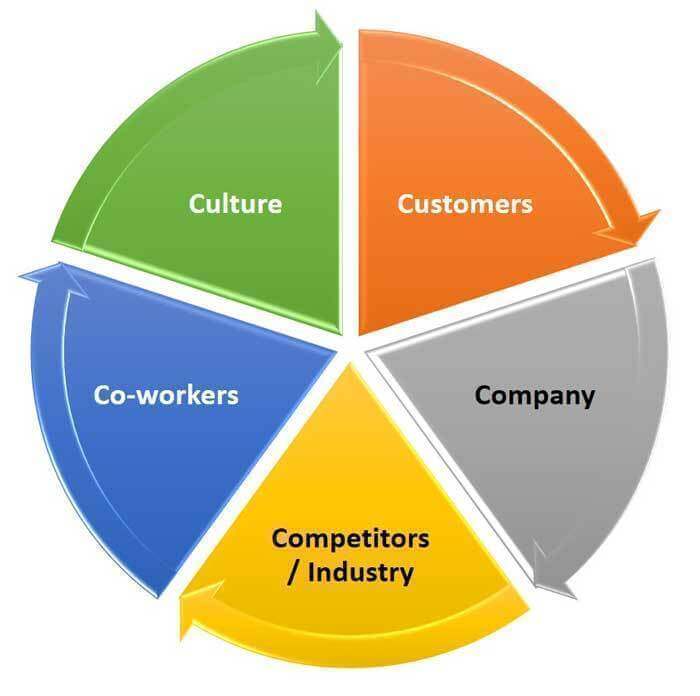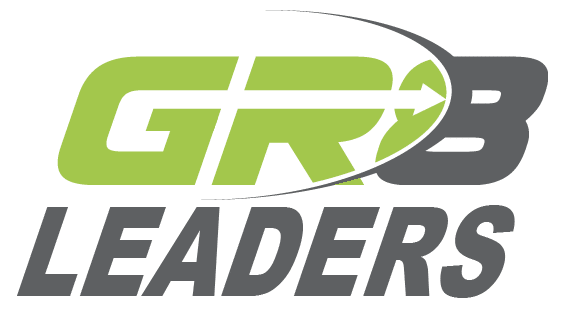Strategic thinkers significantly enhance any project or organization due to their understanding of the entire value-creating system. They see and understand how the parts of the organization fit together. Of course, they do not only look at one piece; they take a comprehensive view of everything.
Here's a tip: if you want to become a strategic thinker and gain a deeper understanding of the system, start with the first strategic thinking competency and start "Thinking Systemically." A helpful process is remembering the 5 C's.

Customers
It is easy to read or hear the word 'customers' and overlook your internal customers. For some roles, such as support functions, you may not interact with external customers, unlike others in your organization. Even so, you still have customers.
Strategic thinkers know that they have people who receive their work product. They also know they are customers of others who provide them with a product or service. When you consider internal customers, you expand your ability to think strategically about more of the business. You can use the following to think about your customers.
- QUESTIONS - Who are my customers? What do they want? How will their wants change? What does my ideal customer look like?
- LEARN MORE - Do customer surveys, arrange focus groups, brainstorm with peers, and become their customers if possible.
Company
How much do you know about your company? Strategic thinkers see their role as part of the process of how the company creates value. So, they pay attention to their work and ensure it adds value rather than detracts from it. They also encourage others to see their role as more than a job - it is how the company provides value to external customers.
- QUESTIONS - What do I not understand about the company strategy? Can I state the company strategy briefly and clearly? Where does my unit fit in that strategy? Where do I fit in that strategy?
- LEARN MORE - Read or listen to the CEO's presentations to the board, investors, and others. Review the company website, newsletters, and other internal sources for information about the company's strategy. Read the company's annual report if it is public. Review the company advertisements and press releases. Look at the marketing and product information. Attend company meetings in which strategies and results are discussed. Volunteer for cross-functional teams and task forces
Competitors/Industry
Competitors can be an obstacle or an opportunity. Strategic thinkers recognize that competition can enhance the company and seek ways to add more value to the products and services it offers. When you think strategically, you look for ways to beat the competition and become a threat to their long-term viability.
- QUESTIONS - Who are our current competitors? What tactics are they using? How are we different from them? Do they possess strengths that could pose a threat to us? What weaknesses might they have that we could exploit? Where is the industry going? What trends in technology, governmental policy, natural resources, and other vital forces might have important implications for us?
- LEARN MORE - Become your competitor’s customer. Look for and read analysts' reports about competitors (of publicly traded companies). Network with other professionals who are familiar with competitors. Attend trade shows to see what your competitors are doing. Read good business publications. Talk with other informed professionals. Participate in trade and professional associations.
Co-workers
Businesses don't get results; people in the business do! You and your co-workers are the reason the company is thriving or not. The attitudes of management and employees drive the quality of products and services. That requires strategic thinkers to help people have the proper attitude about their work and values.
- QUESTIONS - What business processes are impacted by each person? Who's involved in these business processes? How can we assess and know the roles and responsibilities in the processes? What are their goals?
- LEARN MORE - Connect with other managers in the organization to expand your network. Ask about their challenges and needs. Ask them how you could help them achieve their goals. Get their understanding of company strategy formulation, planning, and execution. Learn about their concerns regarding the implementation of ideas you are considering. Discuss with them everyone that’s impacted by your work processes and theirs. How can we make the ideas work for everyone? Do they see problems with your ideas—what are the pitfalls? What are their views on improving your ideas or plans? Ask those whose plans your plans will impact what needs to change to make it work for them.
Culture
Culture is abstract, but becomes tangible when you see people's actions, approaches, and attitudes. It is the overarching structure that demands the behavior of the people in the organization.
While culture may be difficult to assess at the company level, it is easier at the group or team level. Strategic thinkers focus on smaller segments of the business to identify opportunities for improvement. They carry the purpose, values, and leader behaviors to the teams and groups and get the first-line supervisors focused on what is happening in their team. Culture change can be implemented at the team or group level, but it is always subject to the company culture. It will take courage and discipline to be different in a culture that needs to change.
As each team changes to fit the stated core values and purpose, the company's culture begins to change. And always appreciate the need for top management to live the company's core values.
- QUESTIONS - What is the company’s purpose, mission, and values? Which of the values are most and least visible? Is the culture more about performance than who you know? What legal issues are changing the way we do business? Assess how political the environment is. How is the culture changing? Who has power or influence in the organization? Look for those people who are influential without titles. What makes them effective? Who gets things done and has the ear of the decision-makers?
- LEARN MORE - Read your company's Purpose, Mission, and Values statements. Discuss with your supervisor and peers how they define the company's culture. Assess and discuss whether the company's actions align with its Purpose, Mission, and Values.
